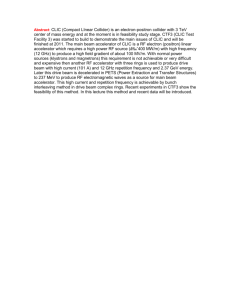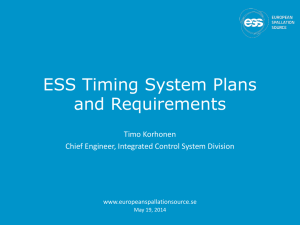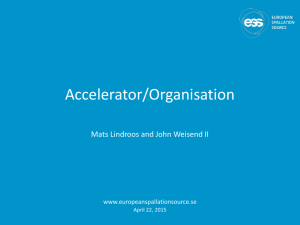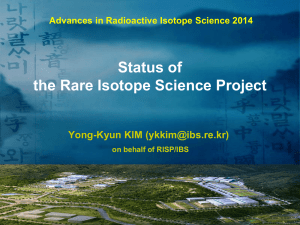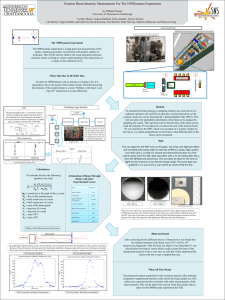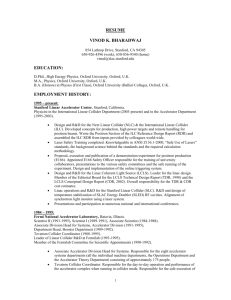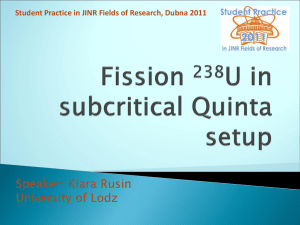ESS_Status_
advertisement
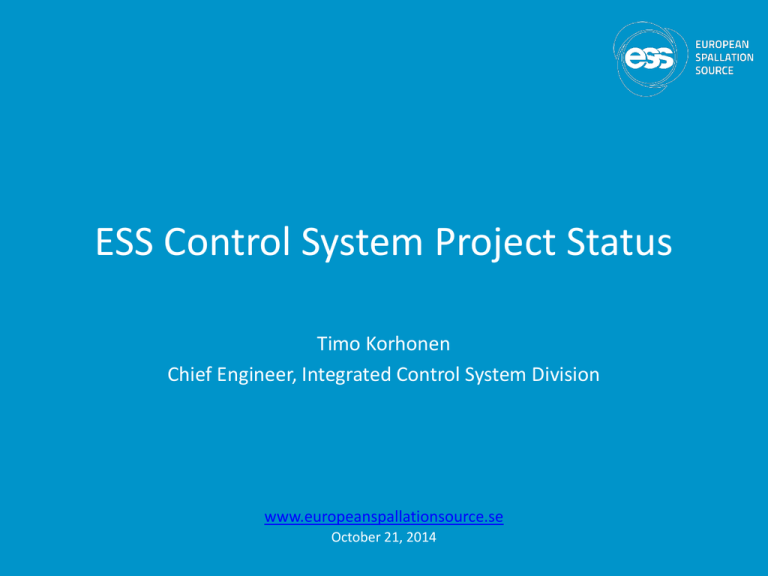
ESS Control System Project Status Timo Korhonen Chief Engineer, Integrated Control System Division www.europeanspallationsource.se October 21, 2014 A European Project Largest&European&science&project& Sweden, Denmark and Norway: ! 50% of construction 15-20% of operations! European partners: 50% of construction! • • • • • • • • • • • • • Sweden 35% Denmark 12.5% Germany 11% United Kingdom 10% France 8% Italy 6% Spain 5% Switzerland 3.5% Norway 2.5% Poland 2% Hungary 1.5% Czech 0.3% Estonia 0.25% 2 Cash vs. In-kind Cash)vs.)In^kind) M€& 400& 350& In^kind)poten, al) In^kind)planned) Cash) 300& 250& 200& 150& 100& 50& 0& 2013& 2014& 2015& 2016& 2017& 2018& 2019& 2020& 2021& 2022& 2023& 2024& 2025& 3 Potencial In-kind ESS&In:kind& contribuOons&potenOal& 4 Construction vs. Operation M€& 5 The European Spallation Source • An accelerator-based neutron source to be built in Lund, southern Sweden – Material and life sciences research • Targeted to be the world’s most powerful neutron source – 5 MW beam power, 2.5 GeV proton energy, 14 Hz repetition rate, 2.86 ms pulse@65 mA beam current – Superconducting linac, rotating tungsten target – 22 neutron beam lines in construction budget 6 The European Spallation Source • First protons planned by 2019 • Project completion by 2025 – Full beam power, 22 neutron beam lines • Accelerator in Lund,Sweden and data processing center in Copenhagen, Denmark 7 Machine layout (200 m) 8 Target and the neutron beam lines Rotating wheel target – beam has to hit in the middle of the sector. 9 Office and experiment areas – nice… 10 ESS construction has started! ESS is funded and Construction is underway! This aerial photo has been taken about some weeks ago. 11 ESS Control System • ESS Integrated Control System Division (ICS) is in charge of building the control system(s) for the accelerator, the neutron target, and providing controls for the beamline components (in cooperation with the colleagues from science directorate) • Project scope includes also – Conventional facilities control integration – Safety & Protection Systems (Machine, Personnel) – Global Timing System for site-wide synchronization • Some parts of the controls will be provided by ESS partner laboratories as in-kind contributions – e.g., proton source and LEBT controls by Saclay (France) 12 Our Organization Garry Trahern Head of Division Deputy Head of Division (vacant) Timo Korhonen – Chief Engineer Miha Reščič – Deputy Project Manager, Lead Systems Engineer Team Assistant (50%) Thilo Friedrich – Systems & Standardization Engineer, PhD PROTECTION SYSTEMS SOFTWARE AND SERVICES Suzanne Gysin – GL HARDWARE AND INTEGRATION Leandro Fernandez Daniel Piso Fernandez Richard Fearn Lead Integrator, Accelerator (vacant) Ricardo Fernandes Lead Integrator, Target (vacant) Emanuele Laface Javier Cereijo, Ph. D student Karin Rathsman Klemen Strniša (C) Jaka Bobnar (C) Urša Rojec (C) Jakob Battellino (C) Niklas Claesson (C) Miha Vitorovič (C) Alexander Söderqvist (C) Jure Krašna (C) Gregor Cijan (C) Annika Nordt – GL Manuel Zaera-Sanz (MPS INFRASTRUCTURE Remy Mudingay Angel Monera (MPS) Riccard Andersson, Ph. D. student Stuart Birch (PSS) Denis Paulic (PSS) Marko Kolar (C) Miroslav Pavleski (C) 13 How many are we…and how many we’ll be 80 80 70 70 60 60 50 50 40 Offsite 40 External 30 Onsite 30 Internal 20 20 10 10 0 0 2013 2014 2015 2016 2017 2018 2019 2020 2021 2013 2014 2015 2016 2017 2018 2019 2020 2021 80 70 60 SENIOR ENGINEER 50 ENGINEER 40 SENIOR SCIENTIST 30 20 10 0 SCIENTIST SENIOR DEVELOPER DEVELOPER 14 Project Structure • Core components – – – – – – WP.2 Applications WP.3 Software core WP.4 Hardware core WP.5 Protection core WP.7 CS Infrastructure WP.8 Physics • Integration support – – – – – WP.10 Accelerator WP.11 Target WP.12 Instruments WP.13 Conventional Facilities WP.14 Test Stands 15 How much? 16 Some technology decisions • Using EPICS for controls in the whole facility – From accelerator to neutron beamlines – Plan to benefit from EPICS version 4 facilities • pvAccess as the binding communicating layer • Services (e.g. physics model as a service) for the accelerator • Participating in the DISCS (Distributed Services for Controls) collaboration – Databases and applications for facility and device configuration data – Middle-layer services (see http://openepics.sourceforge.net/) • CS-Studio as the generic user interface tool – Control room, subsystem developers, etc. • Committed to work together with the EPICS and Accelerator community – Combining our resources we can make more and better things 17 Technology decisions cont. • Using MRF event system for global timing – Synchronization in the whole facility – Timing supports beam synchronous applications (in discussion with PSI about co-development) – Looking at future developments together with some new projects (ELI-Beams, SwissFEL, others) • Machine protection is of prime importance – Ability to switch off beam mid-pulse (10 us time range) • FPGA-based fast interlock • Slow devices connected to PLC-based system – Has to be synchronized with beam operation • Ramping up with beam intensity, pulse length and repetition rate 18 Controls hardware decisions • Defining hardware standards – for the whole spectrum – Standardize on one PLC brand – as far as we can • To reduce complexity – Digital platform form factor • One form factor should cover the segment of fast signal processing – Mainly beam diagnostics and LLRF • Going towards MTCA.4 – carefully, though – Still a new standard with compatibility, etc., issues • Setting up collaborations for a full framework – FMC standards, development framework for the whole cycle (HW&FW&SW) – Plan to use EtherCAT for middle range between PLCs and MTCA • pulse-synchronized operations, distributed, kHz range acquisition 19 Controls platforms • Evaluating motion controller platforms – Current designs based on DeltaTau GeoBrick – Working together with colleagues from science directorate • Controls network design starting • a network and servers expert hired recently • Server hall (Lund site) design ongoing • Starting to look at virtualization solutions – “soft” IOC deployment, development servers • Collaborative tools in heavy use – Atlassian toolkit: JIRA (bugtracker), Confluence (Wiki, web tool) and BitBucket (repository/Git management) 20 Common services • Configuration databases and related tools – (Controls) configuration, cabling, naming service, access control (RBAC) etc. • IOC development workflow and tools – Still searching for optimal development and deployment flow • How to deploy 600+ IOCs in a short time? • How to manage these after deployment? • How to support our off-site partners> – “IOC Factory” – you will hear about that in the future • Use tools from the community whenever possible – CS-Studio, Archiver, Save&Restore, alarm handler – Contribute to development when appropriate • Use resources to develop things that do not exist – Our local infrastructure, for example… 21 Summary • ESS construction has started – New accelerator, new institute, new…everything – Roll up the sleeves and start building systems • Control system effort is ramping up – Moving from prototyping to design decisions – Hiring people (watch our web pages!) – Working in collaborations and with in-kind contributors in member states (still looking for partners) • Lots of things to build – Many challenges, many opportunities 22

